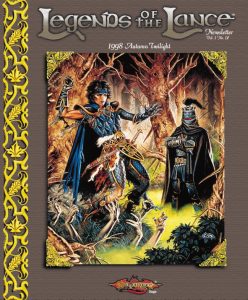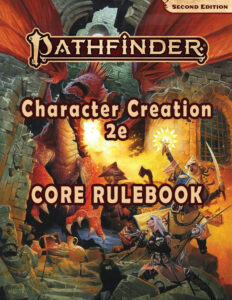
In a world where their lethality is both feared and revered, poisons exist in a shadowy realm of illegality, their use often restricted by stringent laws across diverse societies. Yet, for those who dwell in the darker corners of existence-assassins, dark elves, and other malevolent entities-these deadly concoctions serve as their weapons of choice. The allure of a silent, undetectable killer is too tempting to resist for those bent on malevolence.
While most reputable societies have unequivocally banned the possession and use of these lethal substances, the laws of man have never been airtight. In the hidden crevices of the black market, disreputable apothecaries and unscrupulous dealers hoard secret caches of venom and toxin. A shroud of obscurity veils these forbidden wares, accessible only to those who know where-and how-to look.
For individuals steeped in the criminal underworld, acquiring such poisons may be a relatively uncomplicated affair; a nod from a trusted contact or a secret passphrase could unlock access to a treasure trove of deadly liquids and powders. Yet, for those who walk the straighter paths of life, obtaining these hazardous substances becomes a complex endeavor. It might necessitate diving into the underworld's murky depths, navigating a maze of hearsay and subterfuge, and perhaps even bartering one's morality as bribes exchange hands and ethics are compromised.
In essence, while societal norms and laws try to keep these dangerous substances at bay, a world of clandestine operations ensures that they are never too far out of reach for those desperate-or dark enough-to seek them out.
Poisons come in the following four types.
Contact. A creature that touches contact poison with exposed skin suffers its effects.
Ingested. A creature must swallow an entire dose of ingested poison to suffer its effects. The DM might decide that a partial dose has a reduced effect, such as allowing advantage on the saving throw or dealing only half damage on a failed save.
Inhaled. These poisons are powders or gases that take effect when they are inhaled. A single dose fills a 5 foot cube.
Injury. A creature that takes slashing or piercing damage from a weapon or piece of ammunition coated with injury poison is exposed to its effects.
A Poisoner's Kit isn't just a tool; it's a masterclass in subterfuge and silent warfare, an indispensable asset for thieves, assassins, and all purveyors of deception. With it, you become both an alchemist and an apothecary of death, transforming mundane ingredients into lethal elixirs and applying them with deadly precision. But that's not all-your expertise in toxins provides an uncanny knack for treating and neutralizing them, making you an enigma even in the world of underhanded tactics.
At your Dungeon Master's discretion, proficiency in this tantalizing kit can offer you a powerful edge, amplifying your talents in a variety of high-stakes scenarios. If you possess both the mastery of the Poisoner's Kit and the skill relevant to your situation, the benefits can be extraordinary. Imagine not just succeeding at your task but uncovering layers of hidden knowledge-details that could spell the difference between life and death, victory or defeat.
In the right hands, the Poisoner's Kit is more than just equipment; it's a gateway to power, secrets, and the fine art of treachery.
Kits, like the poisoner's kit and herbalism kit can have same tools and devices to either create a toxin or heal a toxin, to prepare or premade.
Poisoners Kit and Herbalism Kit Contents
Contents of these kits are similar, which may include, but not limited to:
Vials, balms, candle, scale, tweezers, clippers, mortar & pestle, ingredients, oils, venoms, roots, stems, bulbs, spores, powders, darts, needles, stingers, and any other tools they would make the creation of a toxin or antidotes.
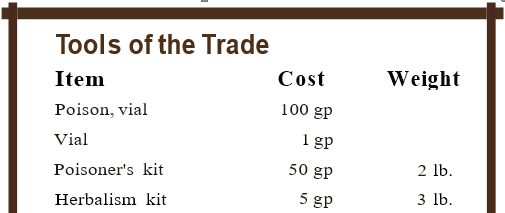
During adventures a character can harvest plants and deceased creatures for naturally occurring poisons and reagents (used in the creation of alchemical poisons). During downtime between adventures, a character can use the poisoner's kit to create alchemical poisons.
A character proficient with the herbalism kit can use it to gather reagents from plants during an adventure. By spending one minute harvesting an appropriate plant a character may gather 1d4 samples to use as a reagent. The following is a list of plants that can be harvested.
A character may be able to purchase various reagents instead of harvesting them. The availability of reagents is always determined by the DM, and some may simply be unavailable in a particular setting.
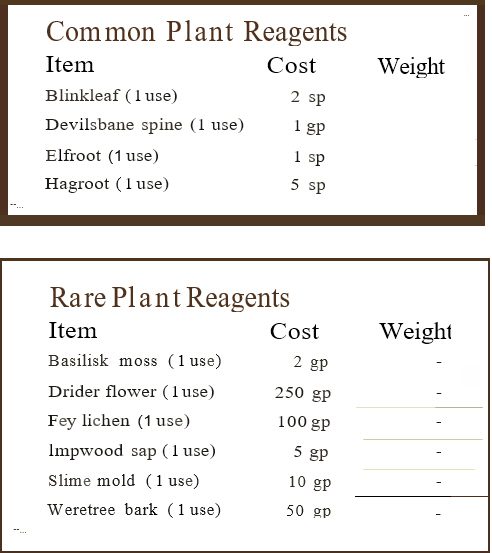
A character may be able to purchase various natural poisons instead of harvesting them. They are generally expensive due to the nature of how they are acquired. The availability of natural poisons is always determined by the DM, and some may simply be unavailable in a particular setting.
A character may be able to purchase various alchemical poisons instead of harvesting them. They are extremely expensive due to the nature of how they are made and the materials involved. The purchase cost is always for 1 dose, regardless of how many are crafted. The availability of alchemical poisons is always determined by the DM, and many may simply be unavailable in a particular setting.
A character proficient with the poisoner 's kit can use it to harvest the following reagents from deceased creatures during an adventure. By spending one minute harvesting an appropriate creature a character may gather 1d4 samples to use as a reagent. The following is a list of creature reagents that can be harvested.
A character may be able to purchase various natural poisons instead of harvesting them. They are generally expensive due to the nature of how they are acquired. The availability of natural poisons is always determined by the DM, and some may simply be unavailable in a particular setting.
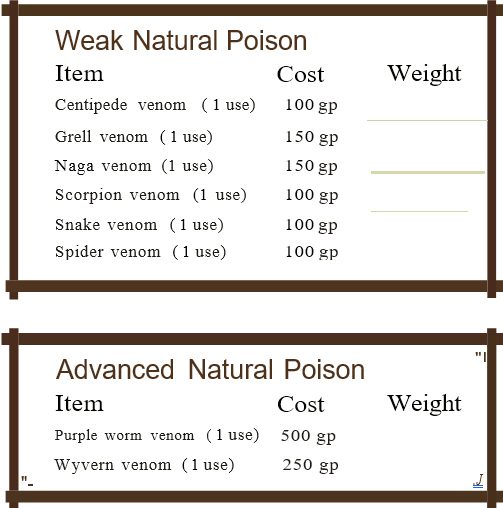
A character can apply a natural poison to coat one slashing or piercing weapon or one piece of ammunition. Applying the poison takes an action. The poison is used on the first successful hit by the poison ed weapon or on the first attack using the poison ed ammunition. Once applied, the poison retains potency for 1 minute before drying.
Natural poison on a slashing or piercing weapon only has one use.
Ammunition coated with a natural poison only has one use and cannot be recovered.
A character can apply an alchemical poison to coat one slashing or piercing weapon or one piece of ammunition. Applying the poison takes an action. The poison is used on the first successful hit by the poisoned weapon or on the first attack using the poisoned ammunition. Once applied, the poison retains potency for 1 hour before drying.
Natural poison on a slashing or piercing weapon only has one use.
Ammunition coated with an alchemical poison only has one use and cannot be recovered.
The extended duration allows multiple weapons and ammunition to be coated with various alchemical poisons prior to combat.
Contact. As an action, you can splash the poison in this vial onto a creature within 5 feet of you or throw it up to 20 feet, shattering it on impact. Make a ranged attack against a target creature, treating the poison as an improvised weapon. On a hit, the target is exposed to the poison.
Ingestion. Due to the nature of ingested poison, this poison must mostly be applied through skullduggery. The use of ingestion poisons is always determined by the DM and is unlikely to often be available during combat. Due to the difficulty involved in using these poisons, they are generally of greater potency.
Inhalation. As an action, you can throw a vial of inhalation poison up to 20 feet, shattering it on impact. The poison fills an area in a 5-foot cube. The poison disperses after 1 minute. A creature is exposed to the poison and must save against it upon entering the area or ending its turn in the area. A creature must make this save only once per turn.
Examples of Poisons
Bane of Knots (injury)
Derived from a variety of plants, this oil causes the muscles to seize and lock. Target must make a DC 13 Constitution save or takes 7(2d6) poison damage and is paralyzed as their muscles all instantly cramp. They can repeat the save at the end of each turn. On a successful save damage is reduced by half and there is no paralysis.
Casket Rot (injury)
Fashioned by boiling the blood of a wight or revenant, this foul concoction slowly kills the flesh. Target must make a DC 17 Constitution save or takes 21 (4d12) necrotic damage and the skin around the wound begins to necrose. Each day, the target repeats the save and, on a failure, takes the damage again. While afflicted with this poison the target cannot be healed by any means. Should they die because of this damage, the next day they will rise as a wight. Succeeding on the save reduces the damage by half and prevents the necrosis of flesh.
Dragon Scale Powder (inhaled)
Taking the scales fresh off a dead dragon and grinding them into a powder, this causes burning pain and leaves the eyes stinging. Target must make a DC 13 Constitution save or takes 6(3d4) fire damage and has disadvantage on attack rolls. This effect ends when the target takes an action to clean their face and eyes using a rag or water. A successful save the target takes no damage but other effects persist.
Jellyfish Sting (contact)
Using the power of toxins in the stinging tentacles of jellyfish, this oil renders a limb inert. Make a melee spell attack roll using Dexterity as your attack modifier. On a hit, deal 9(2d8) lightning damage. The limb you touched is now paralyzed for 1 minute. If it was an arm, a one-handed weapon in that hand is dropped. The target cannot use a two-handed weapon. If you touch a leg, the targets movement is reduced by half.
Madness Spores (inhaled)
Made from the spores of various sentient and non-sentient mushrooms, these spoors cause momentary panic when inhaled. Target must make a DC 14 Wisdom save or takes 7(2d6) psychic damage and spends its turn attacking the nearest creature, friend or foe, thinking it is a fearsome monstrosity. Repeat the save at the end of each turn to end the effect, or when 1-minute passes. On a successful save the target avoids the madness effect.
Ole Jorgen's Tonic (ingested)
Once thought to be medicine to treat various ailments this snake oil is actually just a concoction of herbs that induces vomiting. Target must make a DC 15 Constitution save or begins retching and heaving. This effect lasts 1 minute, and the target is incapacitated while it is in effect.
Rotgut (ingested)
This thick liquid is difficult to disguise as it is distilled from the bodies of oozes. When ingested the target must make a DC 16 Constitution save or take 28 (8d6) poison damage and begins to eat away at the stomach. Repeat the save each hour, and on a failure take an additional 15(4d6) poison damage. An initial save reduces damage to half and prevents further effect. A later save stops the effects from continuing.
Siren's Kiss (contact)
When this strange salve touches the skin, the target feels a rush of euphoria. Make a DC 13 Wisdom save. On a failure the target falls into a dream-like state they cannot be roused from. They will forgo eating, drinking, or sleeping as their mind is in a perfect world of their making. Repeat this save every 24 hours. After 7 days of failed saves the target dies of malnutrition. A successful save the target takes 16(3d10) psychic damage but has no other effects.
Stinging Toxin (injury)
Harvested from glands in giant stinging insects, when applied to a weapon can cause deadly reactions. Target must make a DC 15 Constitution save or take 14(4d6) poison damage and the target is poisoned, taking an additional 5(1d8) poison damage at the start of their turn. They can repeat the save at the end of each turn to end the effects. Successful save reduces damage by half and prevents the poison condition.
Winter Wind (inhaled)
Harvested from the beards of Frost Giants, this powdery snow freezes the lungs when inhaled. Target must make a DC 14 Constitution save or take 10(3d6) cold damage and their lungs and vocal cords become nearly frozen, rendering them unable to speak (silenced) for 1 minute. Successful save reduces damage by half and target is not silenced.



